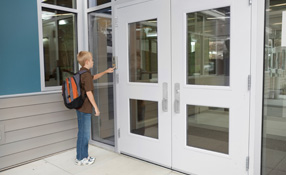 |
| Integrators must understand that the K-12 market has a unique and urgent need for access control, but with limited budgets |
Systems integrators play a key role delivering effective security solutions to the kindergarten through 12th grade (K-12) education market. Schools certainly depend on an integrator’s expertise regarding which electronic products to choose. However, schools also rely the benefit of an integrator’s experience and the insight gained by putting security practices in action on a daily basis. “Schools need integrators who can help them solve problems by performing overall risk assessment and work within their budget to meet their needs,” says Minu Youngkin, Allegion vertical marketing manager.
Forming relationships with school superintendents is one route for integrators into the education market, says Youngkin. However, integrators should also form relationships with other stakeholders, such as architects, general contractors, manufacturers and independent security advisors. Youngkin advises integrators to “follow the money trail.” They should know which districts have bond money and the goals set forth in the bond effort. Integrators can also help districts with grants such as a federal Department of Education hardware grant or a Readiness and Emergency Management for Schools (REMS) grant. Helping districts write grant applications builds goodwill even if the grant request is unsuccessful.
An understanding of the mechanical hardware (as well as the electronics) is foundational to success, says Youngkin. “You have to understand a door opening’s solution in its entirety. In schools, that typically includes a fair amount of mechanical hardware based on how the building is being used as well as Fire Life Safety Codes that dictate the type of hardware you use on certain openings.”
New Technologies Expand Integrator’s Role
Historically speaking, the K-12 school security market often has been driven by low bids with very basic security technology requirements, says Sean McGrath, vice president of marketing and business development, ASSA ABLOY Door Security Solutions. As heightened security needs have taken center stage within school systems, the emergence and benefits of security technology innovation such as wireless and power over Ethernet intelligent access control locks, IP video and emergency communication systems are expanding the integrator’s role, which is becoming increasingly more important in creating secure environments.
Integrators servicing the K-12 education market should be proactively involved with the local committees responsible for defining a school system’s security objectives during the pre-construction phase, says McGrath. In those cases where a school system does not have the budgetary flexibility to hire a professional security consultant to act on their behalf, they will openly embrace the education that many security integrators can provide. The end user community will benefit greatly from integrators taking a consultative approach – not a sales approach – in assisting them to find a balance between the school system’s budgetary framework and its security objectives. It is also important for the end user community to understand the value of a long-term preventative service plan for critical security technology implementation and to budget accordingly post-construction, says McGrath.
Look to Solve Problems, Not Design Systems
School security consultant Paul Timm, president of RETA Security, says schools are getting away from relying on integrators to design systems. More often, integrators are asked to solve problems rather than design systems. He says integrators should be solution-oriented and part of a collaborative team that includes the architect, door hardware people and outside consultants. “Administrators are looking for someone they can trust,” he says.
Integrators can also help to identify funding sources, says Timm. “If integrators were aware of grant programs, that would help schools. Any resources you can bring as an integrator can help.” Knowledge of government or foundation grants, money available from manufacturers such as US Cellular, and other funding sources can be helpful to school systems. “Most schools have no idea of what’s available unless it’s a big statewide program,” he says.
Many K-12 education |
Many K-12 districts lack an experienced security director on premises. In those cases, administrators typically seek out a local security integrator to provide guidance in developing a program, says John Mosebar, vice president, marketing, Aiphone Corp., manufacturer of audio and video intercoms. This is an opportunity for security professionals to maximize their value by providing the equipment and services each campus needs.
The integrator can also help with training on equipment as well as assist in setting policies and procedures for the security function, he says.
Take a Consultative, Solution-Based Approach
Security integrators must address the K-12 market with a consultative, solutions-based approach, says Bruce Montgomery, Business Development Manager, Honeywell. A pitfall can be assuming that all schools face the same challenges and that one previously successful system can be duplicated in its entirety for another school.
“Previous incidents and installations should be studied and referenced to provide proven solutions for managing crisis situations, but it is crucial to couple research and knowledge of previous installations with an open mind to seek out the unique security challenges of a particular school,” says Montgomery. “At Honeywell, our research has indicated that using one integrated family of products improves not only ease of installation but, more importantly for the school districts, a unified platform for improved user experience. “
Integrators must understand that the K-12 market has a unique and urgent need for access control, and they have limited budgets, says Rob Mossman, CEO of Isonas. Superintendents have many constituents to satisfy, from parents to state governments. They have limited time windows for installation, and little room for error. IP cameras expanded quickly into K-12 due to the simplicity and cost savings of IP architecture. An integrator must be savvy to provide solutions that build off existing hardware and software systems, rather than rip and replace. Small legacy systems often need to be taken over, and new doors need to be added. Pure IP access control provides the unique flexibility, speed, cost savings and open architecture that work perfectly in K-12, says Mossman.
Security integrators must address |
Youngkin of Allegion lists some other ways integrators can foster relationships with education clients:
- Apply to be listed on a state’s buying cooperative associations. Schools prefer working through these entities because it eases the procurement process and saves time.
- Attend school association events, networking, industry trade shows.
- Donate money to a bond campaign.
- Develop manufacturer partnerships and leverage the training they provide.
- Help develop a plan and budget that allow schools to consider all the scenarios they face or could potentially face, and put the right resources in place to ensure the best possible outcome.
Youngkin also suggests several questions to ask education clients to direct the security conversation:
- Do you have an emergency/crisis management plan?
- Who manages the security system?
- How do you communicate to staff and teachers in the event of an emergency?
- How do you move through the building on a daily basis (including after school and on weekends)?
- Do you practice lockdowns?
- How does a lockdown work? Are there different levels (i.e., lockout versus lockdown)?
- How long does it take to lock down?
- How do you react based on different times of the day (i.e., recess)?
- What are your goals?














































